14.连词和状语从句
- 格式:wps
- 大小:154.50 KB
- 文档页数:8
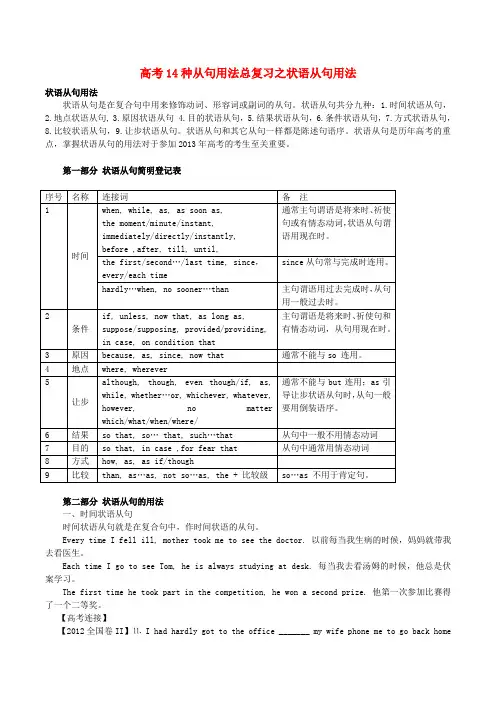
高考14种从句用法总复习之状语从句用法状语从句用法状语从句是在复合句中用来修饰动词、形容词或副词的从句。
状语从句共分九种:1.时间状语从句,2.地点状语从句, 3.原因状语从句 4.目的状语从句,5.结果状语从句,6.条件状语从句,7.方式状语从句,8.比较状语从句,9.让步状语从句。
状语从句和其它从句一样都是陈述句语序。
状语从句是历年高考的重点,掌握状语从句的用法对于参加2013年高考的考生至关重要。
第一部分状语从句简明登记表第二部分状语从句的用法一、时间状语从句时间状语从句就是在复合句中,作时间状语的从句。
Every time I fell ill, mother took me to see the doctor. 以前每当我生病的时候,妈妈就带我去看医生。
Each time I go to see Tom, he is always studying at desk. 每当我去看汤姆的时候,他总是伏案学习。
The first time he took part in the competition, he won a second prize. 他第一次参加比赛得了一个二等奖。
【高考连接】【2012全国卷II】⒒ I had hardly got to the office _______ my wife phone me to go back homeat once.A. whenB. thanC. untilD. after 【答案】A【2012安徽】30. When ________ for his views about his teaching job, Philip said he found it very interesting and rewarding.A. askingB. askedC. having askedD. to be asked 【答案】B【2012山东】27. He smiled politely _______ Mary apologized for her drunken friends.A. asB. ifC. unlessD. though 【答案】A【易错提醒】1、主句的谓语动词是将来时、有情态动词或祈使句,以when, before, after, till, until, as soon as, the moment/minute/second, immediately, instantly, directly等引导的时间状语从句中用一般现在时;如果要表达从句的动作已经完成,主句的动作才发生,从句中用现在完成时。
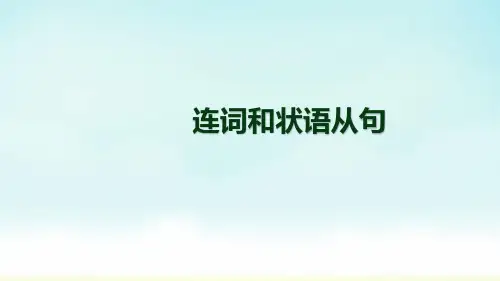
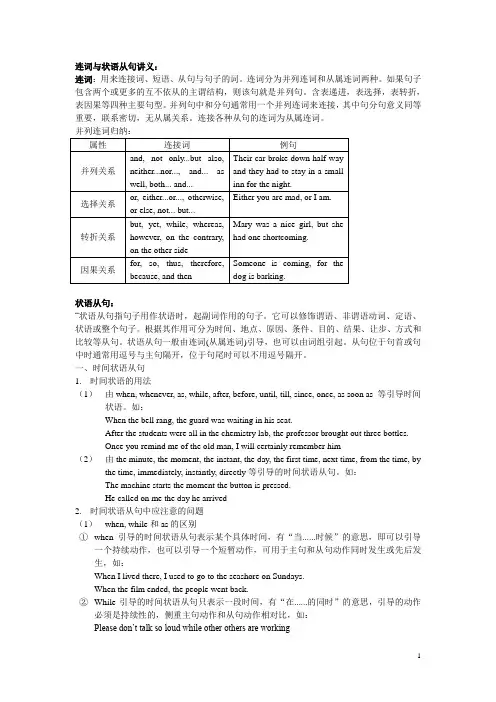
连词与状语从句讲义:连词:用来连接词、短语、从句与句子的词。
连词分为并列连词和从属连词两种。
如果句子包含两个或更多的互不依从的主谓结构,则该句就是并列句。
含表递进,表选择,表转折,表因果等四种主要句型。
并列句中和分句通常用一个并列连词来连接,其中句分句意义同等重要,联系密切,无从属关系。
连接各种从句的连词为从属连词。
并列连词归纳:属性连接词例句并列关系and, not only...but also,neither...nor..., and... aswell, both... and...Their car broke down half-wayand they had to stay in a smallinn for the night.选择关系or, either...or..., otherwise,or else, not... but...Either you are mad, or I am.转折关系but, yet, while, whereas,however, on the contrary,on the other sideMary was a nice girl, but shehad one shortcoming.因果关系for, so, thus, therefore,because, and thenSomeone is coming, for thedog is barking.状语从句:“状语从句指句子用作状语时,起副词作用的句子。
它可以修饰谓语、非谓语动词、定语、状语或整个句子。
根据其作用可分为时间、地点、原因、条件、目的、结果、让步、方式和比较等从句。
状语从句一般由连词(从属连词)引导,也可以由词组引起。
从句位于句首或句中时通常用逗号与主句隔开,位于句尾时可以不用逗号隔开。
一、时间状语从句1.时间状语的用法(1)由when, whenever, as, while, after, before, until, till, since, once, as soon as 等引导时间状语。
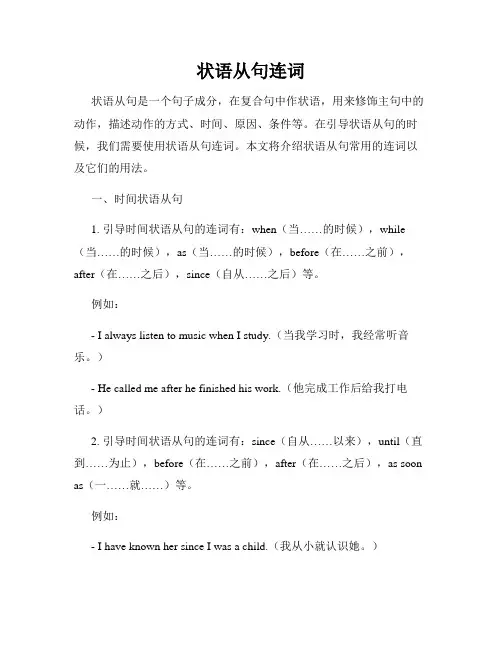
状语从句连词状语从句是一个句子成分,在复合句中作状语,用来修饰主句中的动作,描述动作的方式、时间、原因、条件等。
在引导状语从句的时候,我们需要使用状语从句连词。
本文将介绍状语从句常用的连词以及它们的用法。
一、时间状语从句1. 引导时间状语从句的连词有:when(当……的时候),while (当……的时候),as(当……的时候),before(在……之前),after(在……之后),since(自从……之后)等。
例如:- I always listen to music when I study.(当我学习时,我经常听音乐。
)- He called me after he finished his work.(他完成工作后给我打电话。
)2. 引导时间状语从句的连词有:since(自从……以来),until(直到……为止),before(在……之前),after(在……之后),as soon as(一……就……)等。
例如:- I have known her since I was a child.(我从小就认识她。
)- I will call you as soon as I arrive at the airport.(我到达机场后立即给你打电话。
)二、地点状语从句引导地点状语从句的连词有:where(在哪里),wherever(无论在哪里)。
例如:- He goes to the park where he can play basketball.(他去那个可以打篮球的公园。
)- You can find her wherever you go.(无论你去哪里都可以找到她。
)三、原因状语从句引导原因状语从句的连词有:because(因为),since(既然,因为),as(因为)。
例如:- She couldn't come to the party because she was busy.(她无法参加聚会,因为她很忙。

状语从句分类及常用连词一、状语从句分类及常用连词:类别连词地点状语从句where,wherever时间状语从句when, whenever, while, as, before, after, since, till, once, assoon as,etc.原因状语从句because, since, as, for, now that, etc.目的状语从句in order that, so that, that, etc.结果状语从句so…that, so that, such…that, that, etc.条件状语从句if, unless, as(so)long as, etc.让步状语从句though, although, even if, even though, however, whatever, as,etc.比较状语从句as…as, so…as, than, etc.方式状语从句as, as if, as though, etc.二、各种状语从句的连词的用法区别1 地点状语从句地点状语从句通常由where, wherever 引导。
Where I live there are plenty of trees. 我住的地方树很多。
Wherever I am I will be thinking of you. 不管我在哪里我都会想到你。
2 方式状语从句方式状语从句通常由as, (just) as…so…, as if, as though引导。
1)as, (just) as…so…引导的方式状语从句通常位于主句后,但在(just)as…so…结构中位于句首,这时as从句带有比喻的含义,意思是"正如…","就像",多用于正式文体,例如:Always do to the others as you would be done by.你希望人家怎样待你,你就要怎样待人。
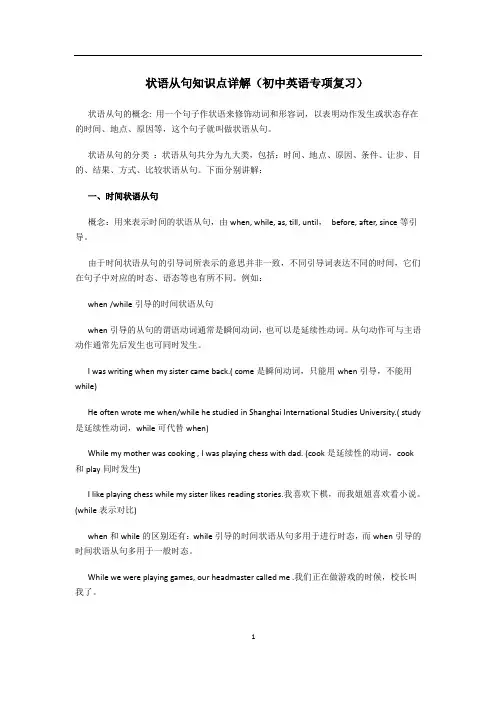
状语从句知识点详解(初中英语专项复习)状语从句的概念: 用一个句子作状语来修饰动词和形容词,以表明动作发生或状态存在的时间、地点、原因等,这个句子就叫做状语从句。
状语从句的分类:状语从句共分为九大类,包括:时间、地点、原因、条件、让步、目的、结果、方式、比较状语从句。
下面分别讲解:一、时间状语从句概念:用来表示时间的状语从句,由when, while, as, till, until,before, after, since等引导。
由于时间状语从句的引导词所表示的意思并非一致,不同引导词表达不同的时间,它们在句子中对应的时态、语态等也有所不同。
例如:when /while引导的时间状语从句when引导的从句的谓语动词通常是瞬间动词,也可以是延续性动词。
从句动作可与主语动作通常先后发生也可同时发生。
I was writing when my sister came back.( come是瞬间动词,只能用when引导,不能用while)He often wrote me when/while he studied in Shanghai International Studies University.( study 是延续性动词,while可代替when)While my mother was cooking , I was playing chess with dad. (cook是延续性的动词,cook和play同时发生)I like playing chess while my sister likes reading stories.我喜欢下棋,而我姐姐喜欢看小说。
(while表示对比)when和while的区别还有:while引导的时间状语从句多用于进行时态,而when引导的时间状语从句多用于一般时态。
While we were playing games, our headmaster called me .我们正在做游戏的时候,校长叫我了。

连词和状语从句专题复习教学设计一、考点分析连词和状语从句是中考词汇和句法部分考查的重点内容之一,尤其是状语从句也是学生比较熟识的一种复合句,近几年中考重点是考查状语从句的时态呼应,尤其是时间状语从句和条件状语从句,另外引导状语从句的连接词也是常考点之一。
二、学生分析在前一阶段,学生基本上已经复习完各个词类的专项复习,从本星期开始进入句子的复习;而状语从句对于学生来说是比较熟识,状语从句的学习是贯穿在整个初中的学习阶段,但状语从句的时态呼应对于部分学生来说还是一个难点,特别在翻译句子时总是忘了时态的呼应。
所以把前面复习过的连词和今天的从句放在一起,再进行综合性的系统复习。
三、教学目标1、掌握连词和状语从句的种类和结构2、掌握状语从句(时间状语从句和条件状语从句)的时态呼应3、能口头和笔头熟练使用连词所引导的各种状语从句四、教学重点状语从句的连接词时间状语从句和条件状语从句的时态呼应五、教学难点能在口头和笔头熟练使用各种状语从句六、教学策略归纳法和启发式教学七、教学媒体多媒体和练习卷八、教学步骤Step 1 Lead-in1. Warming –upWatch a video. It is a beautiful day , but I can’t see it.(To arouse the Ss’interest and lead in the revision topic )Q 1:What’s the passage mainly about ? Q2:ask Ss use the conj. corectly , change your words ,change your world.2. Show Ss’compitationsts o the students and then ask them to read the passage silently and quickly, and then answer some questions. (To direct the students to find out the Adverbial Clauses in the passage) Step 2 Revision1. To go over the kinds of the Adverbial Clauses and conj.( show on the blackbord )状语从句的种类(1)、时间状语从句when, while, as soon as, since, until, before, after (2)、条件状语从句if unless as soon as(3)、结果状语从句so…that such…that(4)、比较状语从句than as…as , not so …as(5)、原因状语从句because ,since(因为,既然), as (由于)(6)、让步状语从句although, though enve if(7)、目的状语从句so that in odrer that2. Let the Ss remember the words, then write them on the blackbord.Step 3 Practice (具体练习参看学生用卷)Let the Ss do some exercises and then check the answers ( To check how the students understand the usages of the Adverbial Clauses) 学生用卷1.--This dress was last year’s style.-- I think it will still look perfect it is not in fashion.A so thatB even thoughC as ifD ever since2. ---Are you going to Mary’s party ? --- I won’t I ‘m invited.A WhenB afterC unlessD if3. If you don’t go to the meeting tomorrow, .A . I will , tooB I won’t , eitherC I do , tooD I don’t , either4.---We’d better not talk about it Mary leaves.---Why not ask her to join us ?A afterB untilC ifD though5. Mary, hurry up ! we can’t arrive on timeA orB soC ButD And6.You will make progress____ you try your best.A as soon asB as long asC as well asD as far as7. They spoke quietly I could hardly hear them .A such thatB so thatC neither norD both and8 When some one is in trouble , he she should try to smile at life .A orB soC butD and9 I don’t know when he If he here , I’ll call you .A will come ,will arriveB comes , arrivesC will come , arrivesD comes , will arrive10. ---I wonder when you in New York..---I will send an e-mail to you asa soon as I there.A arrive,will getB will arrive , getC will arrive , will getD arrive , get11 小练笔:假如你是John ,你的好友Mary 最近因为考试临近而压力倍增,请你给她一些建议,让她多出去走走,放松身心,多做运动,也可以和朋友聊天。
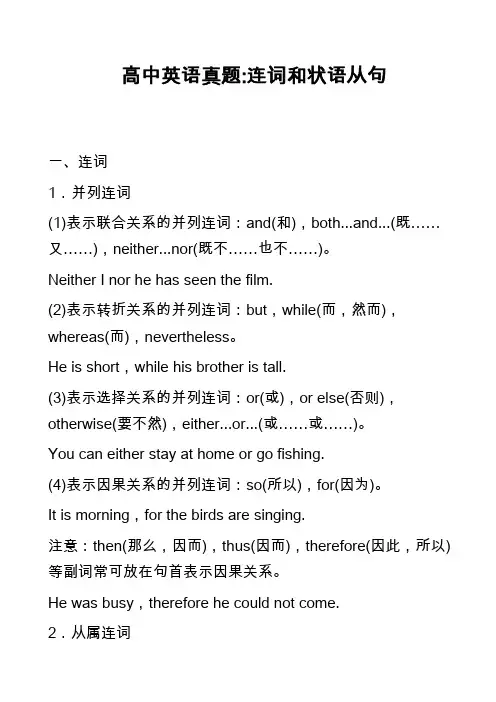
高中英语真题:连词和状语从句一、连词1.并列连词(1)表示联合关系的并列连词:and(和),both...and...(既……又……),neither...nor(既不……也不……)。
Neither I nor he has seen the film.(2)表示转折关系的并列连词:but,while(而,然而),whereas(而),nevertheless。
He is short,while his brother is tall.(3)表示选择关系的并列连词:or(或),or else(否则),otherwise(要不然),either...or...(或……或……)。
You can either stay at home or go fishing.(4)表示因果关系的并列连词:so(所以),for(因为)。
It is morning,for the birds are singing.注意:then(那么,因而),thus(因而),therefore(因此,所以)等副词常可放在句首表示因果关系。
He was busy,therefore he could not come.2.从属连词(1)引导名词性从句的从属连词引导名词性从句的从属连词有连接词:that,whether和if,这些连接词在句中不充当任何句子成分;连接代词主要有:who,whom,whose,which,what等,它们在句中可作主语、宾语、定语等;连接副词主要有:when,where,how,why等,它们在句中可作状语。
We know (that) the earth goes round the sun.What we need is more time.That’s what I want.(2)引导状语从句的从属连词在句中作状语的从句叫状语从句,也叫副词性从句。
它修饰谓语、非谓语动词、状语或整个句子。
状语从句由从属连词引导,可表示时间、地点、条件、原因、结果、目的、让步、比较、方式等。

状语从句在英语语法中扮演着重要的角色。
它们可以用来修饰动词、形容词和副词,从而增强句子的表达力和准确性。
同时,连词在连接状语从句与主句之间起到了关键作用。
本文将探讨英语中的状语从句以及常用的连词。
首先,让我们来了解一下什么是状语从句。
状语从句是一个从句,它在句子中作为副词一样的角色,修饰句子的动词、形容词或副词。
状语从句可以用来表示时间、原因、条件、目的、结果等。
状语从句的引导词有很多种,最常见的包括:when(当),while(当...时),after(之后),before(之前),since(自从),as(当...时候),because(因为),although(尽管),if(如果),unless(除非),as if (好像),so(因此),so that(以便),in order that(为了),although(虽然)等等。
这些引导词可以帮助我们把状语从句与主句连接起来,并使句子更加清晰明了。
接下来,我们来看看一些例子,以更好地理解状语从句和连词的使用。
首先是时间状语从句:“I watched a movie when I got home.”(我回到家后看了一部电影。
)这里,“when”引导的状语从句修饰主句中的动词“watched”,表达了事件发生的时间。
接着是原因状语从句:“He failed the exam because he didn't study.”(他没通过考试是因为他没学习。
)这里,“because”引导的状语从句修饰主句中的动词“failed”,表达了失败的原因。
再来是条件状语从句:“If it rains, we will stay indoors.”(如果下雨,我们会呆在室内。
)这里,“if”引导的状语从句修饰主句中的动词“will stay”,表达了条件。
还有目的状语从句:“I bought a new laptop so that I can work more efficiently.”(我买了一台新笔记本电脑,以便我可以更高效地工作。
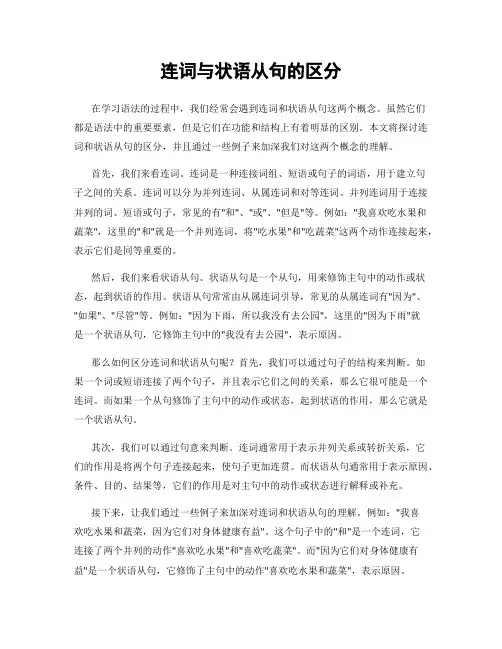
连词与状语从句的区分在学习语法的过程中,我们经常会遇到连词和状语从句这两个概念。
虽然它们都是语法中的重要要素,但是它们在功能和结构上有着明显的区别。
本文将探讨连词和状语从句的区分,并且通过一些例子来加深我们对这两个概念的理解。
首先,我们来看连词。
连词是一种连接词组、短语或句子的词语,用于建立句子之间的关系。
连词可以分为并列连词、从属连词和对等连词。
并列连词用于连接并列的词、短语或句子,常见的有"和"、"或"、"但是"等。
例如:"我喜欢吃水果和蔬菜",这里的"和"就是一个并列连词,将"吃水果"和"吃蔬菜"这两个动作连接起来,表示它们是同等重要的。
然后,我们来看状语从句。
状语从句是一个从句,用来修饰主句中的动作或状态,起到状语的作用。
状语从句常常由从属连词引导,常见的从属连词有"因为"、"如果"、"尽管"等。
例如:"因为下雨,所以我没有去公园",这里的"因为下雨"就是一个状语从句,它修饰主句中的"我没有去公园",表示原因。
那么如何区分连词和状语从句呢?首先,我们可以通过句子的结构来判断。
如果一个词或短语连接了两个句子,并且表示它们之间的关系,那么它很可能是一个连词。
而如果一个从句修饰了主句中的动作或状态,起到状语的作用,那么它就是一个状语从句。
其次,我们可以通过句意来判断。
连词通常用于表示并列关系或转折关系,它们的作用是将两个句子连接起来,使句子更加连贯。
而状语从句通常用于表示原因、条件、目的、结果等,它们的作用是对主句中的动作或状态进行解释或补充。
接下来,让我们通过一些例子来加深对连词和状语从句的理解。
例如:"我喜欢吃水果和蔬菜,因为它们对身体健康有益"。
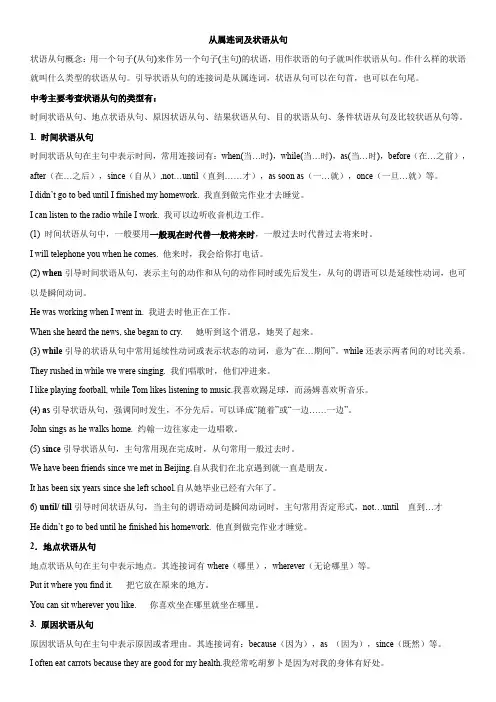
从属连词及状语从句状语从句概念:用一个句子(从句)来作另一个句子(主句)的状语,用作状语的句子就叫作状语从句。
作什么样的状语就叫什么类型的状语从句。
引导状语从句的连接词是从属连词,状语从句可以在句首,也可以在句尾。
中考主要考查状语从句的类型有:时间状语从句、地点状语从句、原因状语从句、结果状语从句、目的状语从句、条件状语从句及比较状语从句等。
1. 时间状语从句时间状语从句在主句中表示时间,常用连接词有:when(当…时),while(当…时),as(当…时),before(在…之前),after(在…之后),since(自从),not…until(直到……才),as soon as(一…就),once(一旦…就)等。
I didn’t go to bed until I finished my homework. 我直到做完作业才去睡觉。
I can listen to the radio while I work. 我可以边听收音机边工作。
(1) 时间状语从句中,一般要用一般现在时代替一般将来时,一般过去时代替过去将来时。
I will telephone you when he comes. 他来时,我会给你打电话。
(2) when引导时间状语从句,表示主句的动作和从句的动作同时或先后发生,从句的谓语可以是延续性动词,也可以是瞬间动词。
He was working when I went in. 我进去时他正在工作。
When she heard the news, she began to cry. 她听到这个消息,她哭了起来。
(3) while引导的状语从句中常用延续性动词或表示状态的动词,意为“在…期间”。
while还表示两者间的对比关系。
They rushed in while we were singing. 我们唱歌时,他们冲进来。
I like playing football, while Tom likes listening to music.我喜欢踢足球,而汤姆喜欢听音乐。
状语从句的引导词与连接词状语从句是指在句子中作状语的从句。
它可以修饰动词、形容词、副词等,用来表达时间、原因、条件、目的、结果、比较等等。
状语从句的引导词与连接词是非常重要的,它们在句子中起到引导和连接的作用。
本文将介绍常见的状语从句引导词与连接词。
一、时间状语从句引导词与连接词1. when:当……的时候例句:I always go for a walk in the park when I finish work.2. while:当……的时候例句:She likes to listen to music while doing her homework.3. as soon as:一……就例句:Please call me as soon as you arrive at the airport.4. before:在……之前例句:We should finish our homework before we go out to play.5. after:在……之后例句:I like to relax after I finish my work.二、原因状语从句引导词与连接词1. because:因为例句:He didn't go to the party because he had to study for the exam.2. since:因为例句:She couldn't come to the meeting since she was not feeling well.3. as:因为例句:As it was raining, we decided to stay indoors.4. considering that:鉴于……例句:Considering that he is so young, he is very talented.三、条件状语从句引导词与连接词1. if:如果例句:I will go to the concert if I can get a ticket.2. unless:除非例句:I won't go to the party unless you come with me.3. in case:以防万一例句:Take an umbrella with you in case it rains.4. provided that:只要例句:You can use my laptop provided that you don't delete any files.四、目的状语从句引导词与连接词1. so that:以便例句:She studies hard so that she can get good grades.2. in order to:为了例句:He woke up early in order to catch the first train.3. for fear that:以免例句:He spoke softly for fear that he might wake the baby.五、结果状语从句引导词与连接词1. so...that:如此……以至于例句:The book was so interesting that I couldn't put it down.2. such...that:如此……以至于例句:He gave such a great speech that everyone applauded.3. therefore:因此例句:She was late for the meeting, therefore she missed an important discussion.六、比较状语从句引导词与连接词1. as...as:和……一样例句:She is as intelligent as her sister.2. not as/so...as:不如例句:He is not as tall as his friend.3. than:比例句:He is taller than his sister.总结:状语从句中的引导词与连接词在句子中起到引导和连接的作用,帮助我们表达时间、原因、条件、目的、结果和比较等等。
第十四、五讲并列连词和状语从句一学习目标1.了解怎么考、怎么学、怎么解。
2.体会考试方向。
3.探析正误探究。
4.掌握考点确认二考点清单Ⅰ.⊙怎么考1.重点考查从属连词及句式;2.某些固定句式;如:before、while等。
3.状语从句的省略。
⊙怎么学在平时的学习中,认真体会学习、运用:1.although,though,even if,even though,as引导的让步状语从句;2.时间状语从句;3.if,unless,as/so long as,in case,on condition that等引导的条件状语从句。
⊙怎么解1.思考其语法特征和语义特征,注意区分意义相近的关系词。
2.注意对语序的考查。
3.注意与其他从句的区别。
Ⅱ.体会一下考试方向1.(2016·浙江卷,5)________ online shopping has changed our life,not all of its effects havebeen positive.A.Since B.After C.While D.Unless答案C[考查连词。
句意:尽管上购物已经改变了我们的生活,但是不是所有的影响都是积极的。
while引导让步状语从句,意为“尽管,虽然”;since既然,自从;after在……之后;unless除非。
故选C。
]2.(2016·江苏卷,26)________ some people are motivated by a need for success,others aremotivated by a fear of failure.A.Because B.If C.Unless D.While答案D[考查让步状语从句的用法。
句意:尽管有些人受到成功需求的激励,而另外一些人却因恐惧失败而退缩。
根据句意可知,这两句话之间为转折对比关系,故要用while。
]3.(2016·北京卷,27)My grandfather still plays tennis now and then,________ he's in hisnineties.A.as long as B.as if C.even though D.in case答案C[考查连词。
连词和状语从句考情分析:从近五年考查情况来看,连词是每年的必考点,其中并列连词的基本用法是重要考点,对从属连词的考查一般结合状语从句来考查,状语从句的时态(主将从现)也是一个常考点。
2017年备考时应掌握好并列连词的基本用法,对从属连词的基本用法和状语从句的时态(主将从现)也应注意。
考点突破考点一: 并列连词的基本用法并列连词按作用可分为表示联合、转折、选择和因果等四大类。
1.表联合关系的并列连词常见的有:(1)and意为“和,又,而,并且”。
如:I like English and math.我喜欢英语和数学。
(2)not only...but also(but as well) 意为“不但……而且……”。
如:Not only my father but also my mother likes watching TV very much.不但我的爸爸,而且我的妈妈也非常喜欢看电视。
(3)as well as 意为“也”。
如:He needs a knife as well as a piece of paper.他需要一把小刀,也需要一张纸。
(4)either...or... 意为“或……或……;不是……就是……”。
either...or... 连接两个主语时,谓语动词的单复数和其邻近的词保持一致,即由or后面的词而定。
如:Either he or I am going to have a meeting.要么他,要么我将参加会议。
(5)neither...nor... 意为“既不……也不……”。
当此词组连接两个主语时,谓语动词的用法和either...or...的用法一样,由nor后面的词而定。
如:Neither the teacher nor the students are happy.老师和学生都不开心。
(6)both...and... 意为“既……又……”。
连接两个主语时,谓语动词用复数形式。
如:Both Mary and Lily are from America.玛丽和莉莉都来自美国。
2.转折连词常见的有:but,while(而),yet,however(然而)。
如:He likes sports,but he only watches them on TV.他喜欢体育,但是只在电视上观看。
My sister was doing her homework while I was playing computer games.我的妹妹在做作业,而我在玩电脑游戏。
Both Mary and Lily are from America.玛丽和莉莉都来自美国。
3.选择连词常见的有:or,otherwise。
如:Would you like tea or coffee? 你要茶还是咖啡?Hurry up,otherwise we can't catch the bus.快点,否则我们赶不上车。
重要的句型:祈使句+or...=if you don't...,you'll... 意为“请……,否则……”。
如:Don't go out,or you will catch a cold.请不要出去,否则你会感冒的。
4.因果连词常见的有: for,so和therefore等。
其中for引导的句子不表示直接原因,而是用来附带解释或说明前一句的情况,只用在句中,前后两个句子用逗号隔开。
如:You'd better put on your sweater,for it's cold outside.你最好穿上毛衣,外面冷。
My father is waiting for me,so I have to go.爸爸在等我,所以我要走了。
It is going to rain,therefore we have to put off the match.要下雨了,因此我们不得不推迟比赛。
()1. I have only two tickets for TFBoys' concert. ______ you ______ he can go with me.A.Either;orB.Neither;norC.Both;andD.Not only;also()2. Think it over, ______ you'll work out the math problem.A.orB.soC.forD.and()3. Ben was busy taking a training class,______ we had to wait for him for half an hour. A.so B.if C.or D.but()4. ______ you ______ your brother can join us.We want one of you.A.Both;andB.Neither;norC.Either;orD.Not only;but also()5. We have to get up at 7:15 tomorrow morning,______we will be late for the 7:40 train. A.before B.or C.if D.so()6. Basketball has a history of nearly 300 years.Today it is still loved by ______ the young______ the old.A.both;andB.either;orC.not;butD.neither;nor()7. There are no buses,______ you'll have to walk.A.soB.orC.butD.for()8.Martin and his friends didn't eat up all the food they ordered,______they took the rest away.A.forB.orC.soD.as()9. ______ Tony ______ Frank likes the C D.They think the music is too noisy.A.Neither;norB.Either;orC.Both;andD.Not only;but also()10.—Where is Leo? He said he would come tonight!—Yes, he did say so,______ we can't find him now.A.andB.soC.butD.or考点二: 从属连词引导状语从句的从属连词:(1)连接时间状语从句的从属连词有:since,until,after,before,when,while,as,as soon as,whenever,ever since等。
如:His father came back home while he was watching TV.他在看电视的时候,他爸爸回家了。
(2)连接让步状语从句的从属连词有:although,though,even if,however等。
如:The old man plays sports every morning,although he is over 70 years old.虽然那个老人70多岁了,但他每天早晨都锻炼身体。
(3)连接原因状语从句的从属连词有:as,because,since,now that等。
如:Let's go to a movie,since we are free now.既然现在我们有时间,那去看电影吧。
(4)连接目的状语从句的从属连词有:that,so that,in order that等。
如:Mr.Black ran fast in order that he could catch the train.布莱克先生为了赶火车而快跑。
(5)连接条件状语从句的从属连词有:if,unless,once,in case等。
如:Her father won't buy her a present unless she gets good grades.除非她取得好成绩,不然她爸爸不会给她买礼物的。
(6)连接结果状语从句的从属连词有:so...that,such...that等。
如:This movie was so boring that we were sleepy.这场电影如此无聊,以至于我们都困了。
()1. The traffic policeman took away the driver's license______he broke the traffic rules ofdrunk driving.A.thoughB.becauseC.tillD.and()2. —Shall we go for a picnic in the forest park tomorrow?—Yes, ______it rains heavily.A.ifB.unlessC.untilD.when()3. I won't believe that the five-year-old boy can read magazines ______ I test him myself. A.if B.when C.after D.until()4. ______ I got home, my sister was doing her homework.A.WhenB.BecauseC.IfD.Though()5. —Why didn't you try your best to get on the subway?—I tried to,but it started moving______I could get on it.A.beforeB.afterC.sinceD.if()6. —I can hardly believe my eyes.Is that you, Lucy?—Yes.It has been almost 20 years ______ we were together.A.sinceB.beforeC.afterD.until考点三: 状语从句的时态1.用法:if(如果),as soon as(一……就……),until(直到……才……),when(当……时),before(在……之前),after(在……之后),unless(除非)等词连接的时间、条件或让步状语从句时,主句用将来时(有时候是祈使句),从句用一般现在时表将来。